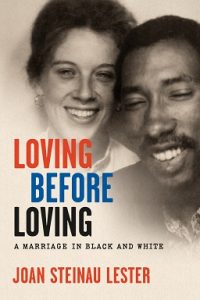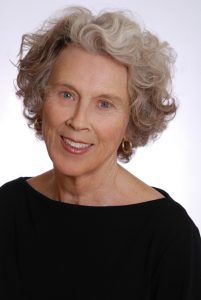Writing Loving before Loving: A Marriage in Black and White, Joan Steinau Lester
If I had a nickel for each time a stranger has told me, “I know my life wo uld be a bestseller!” I’d be wealthy. Sometimes they even offer their story, asking me to simply write it down. “My life has been so amazing, the book would write itself.”
uld be a bestseller!” I’d be wealthy. Sometimes they even offer their story, asking me to simply write it down. “My life has been so amazing, the book would write itself.”
Well, not really. Books do not write themselves, and the record of lives is not laid out like a script, awaiting only transcription. A memoir, like any other book, is a deliberately created piece of art, using, in this case, one’s life as the clay. But there are endless possibilities for shaping the raw material. What is the theme? The voice? Which events to include, which to highlight, how to connect them all? And why now?
On the morning of December 5, 2013, I stood by my mother, Barb, holding her cool hand while she lay stretched out, unconscious, on a hospital bed in her living room. My sister, her partner, and I kept vigil for twelve days and nights, never leaving her alone. Now her breath rattled loudly. We understood the end was near. Yet the moment Barb suddenly went silent I screamed for my sister, “Come! I think she stopped breathing!” and began to shake. Just like that, I had no living parent.
For six months I grieved, so adrift I even informed startled friends, “I may not write anymore.” After this profound loss, nothing mattered.
Yet eventually my fingers itched for the smooth feel of computer keys, and for the magical space writing opens in me. Abandoning long-suspended work on a contracted novel, I plunged into memoir. The need to make sense of my life—mine alone, not as anyone’s daughter–skyrocketed, and the freedom, even from a loving parent, to say anything, unshackled me. I felt entirely free to speak my truth.
For three years I wrote, pounding out pages with various titles. Eventually, I sent my draft to an agent who, based on the first chapter, agreed to read it.
She praised the writing but “felt that the overall narrative was somewhat uneven. At times we were so invested and at other parts skimming. NOT because the writing isn’t strong (man it is!) but because there were so many tangents. I think the issue is that you have SO MUCH to say that it must have been hard for you to limit which parts to share. There are like 4 different books here! And while each individual story is lovely, they confuse the flow of the narrative….Is this a book about breaking racial barriers, is this a book about gay marriage, is this a book about education, is this a book about writing?”
The agent, fortunately, liked the manuscript enough to retain an editor who supervised revisions as I settled on the coming-of-age-as-writer/activist theme.
It didn’t sell.
One afternoon I called a highly recommended publicist I hoped to engage, thinking she might help me publish a major essay that might attract a publisher.
“What’s the memoir about?” she asked.
“It’s my work in the civil rights movement…” I began, naively believing that she, as a Black woman, would be riveted.
“Yawn,” she said.
“And my marriage to a Black man in the early 60s, our children…” I continued.
“Now that’s a subject I’d be interested in. What was it like to be interracially married back then?”
“Well,” I stammered, vowing silently, Never! My ex-husband had become famous during our eight-year marriage, when his first book—which I edited—shot into the stratosphere, garnering glowing New York Times reviews. While I, an aspiring writer, stayed mired in diapers and dishes.
When my wife of forty years heard the publicist’s response, she enthused, “That’s a great idea. It’s a framework to hang your story on. You can still talk about becoming a writer. After all, he was your first mentor, and it gives you a personal vehicle to talk about race. All your anti-racism work.”
“No.” I shook my head. “Julius Lester got so much attention. I am not going to focus the story of my life on him.”
“The publicist is a good barometer, Joan. And that relationship was foundational. Your writing, your children, your doctorate. Your profession. Marrying him set the entire trajectory of your life.”
A few days later I warily approached the manuscript. First I stripped away the first five chapters, over which I’d labored for years. Now page one showed me meeting Julius and our embarrassing first exchange, an explosive racially-tinged misunderstanding. I expanded his character and used that relationship as a theme right to the final pages of the book, showing how it deepened in the decades following our divorce, right up to his warm condolences after my mother died.
The first publisher my agent sent this version to bought it, and I realized that this long-ago marriage had to be my theme. As I revised I worked on forgiveness—of Julius, and myself, for the ways we failed each other—and ended up feeling closer to him, grateful for our coupling, despite the pain. My wife was right: that first marriage to a gifted writer, a Black man at a time when our union was still illegal in twenty-seven states, indeed set my life course.
I didn’t know when I started this memoir which story I would tell—which is why strangers proffering stories of their “amazing lives” can’t provide the effortless books they believe in. But I was fortunate to eventually find my theme, one hiding in plain sight all along. Once I cut away extraneous material its perfection grew clear, like the elegant lines that emerge after pruning a tree. And as suddenly as my mother took her last breath, one morning while I lay quietly in bed a perfect title popped into my mind, confirming the rightness of my choice.
The writing process is indeed a magical one, and I am grateful to have gone through it enough times that I allowed myself the many revisions it took to find my way, confident the right story would someday emerge.
#######
 Joan Steinau Lester is the author of six books, including the forthcoming memoir Loving Before Loving: A Marriage in Black and White (May 18, 2021, University of Wisconsin Press)
Joan Steinau Lester is the author of six books, including the forthcoming memoir Loving Before Loving: A Marriage in Black and White (May 18, 2021, University of Wisconsin Press)
Find more about Joan on her Website http://www.joanlester.com/
Follow her on Twitter https://twitter.com/joan_lester
LOVING BEFORE LOVING: A MARRIAGE IN BLACK AND WHITE
“This book is the real deal, the way it was. I love it!” Alice Walker, Pulitzer Prize-winning author of The Color Purple
Committed to the struggle for civil rights, in the late 1950s Joan Steinau marched and protested as a white ally and young woman coming to terms with her own racism. She fell in love and married a fellow activist, the Black writer Julius Lester, establishing a partnership that was long and multifaceted but not free of the politics of race and gender. As the women’s movement dawned, feminism helped Lester find her voice, her pansexuality, and the courage to be herself.
Braiding intellectual, personal, and political history, Lester tells the story of a writer and activist fighting for love and justice before, during, and after the Supreme Court’s 1967 decision striking down bans on interracial marriage in Loving v. Virginia. She describes her own shifts in consciousness, from an activist climbing police barricades by day and reading and writing late into the night to a woman navigating the coming-out process in midlife, before finding the publishing success she had dreamed of. Speaking candidly about every facet of her life, Lester illuminates her journey to fulfillment and healing.
Order now from local bookstores or online
Category: On Writing
























